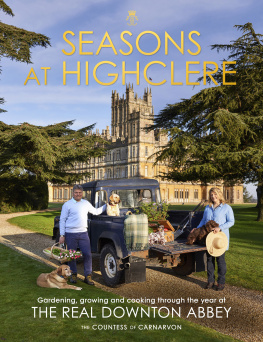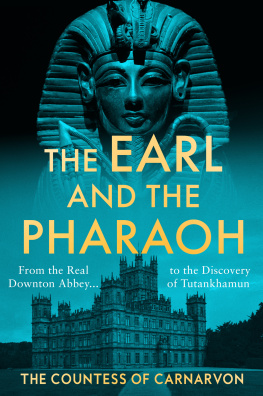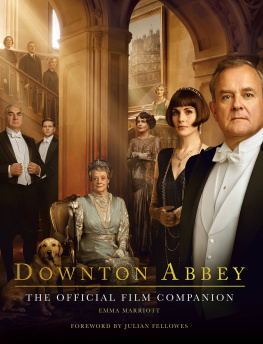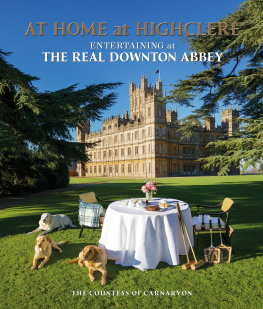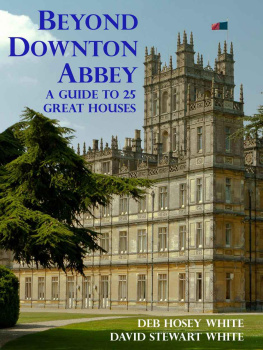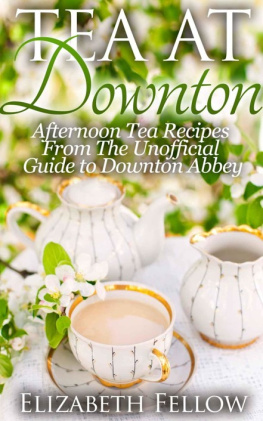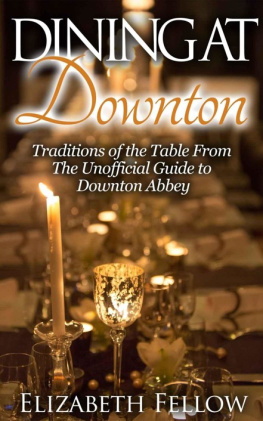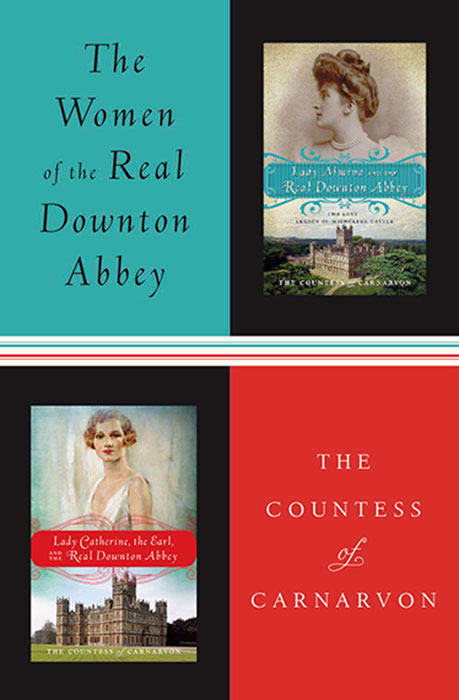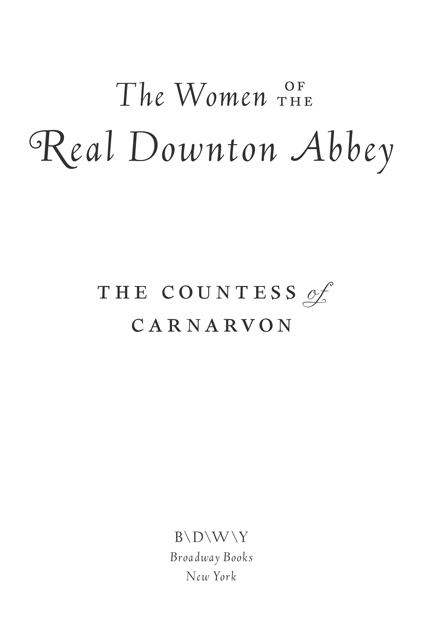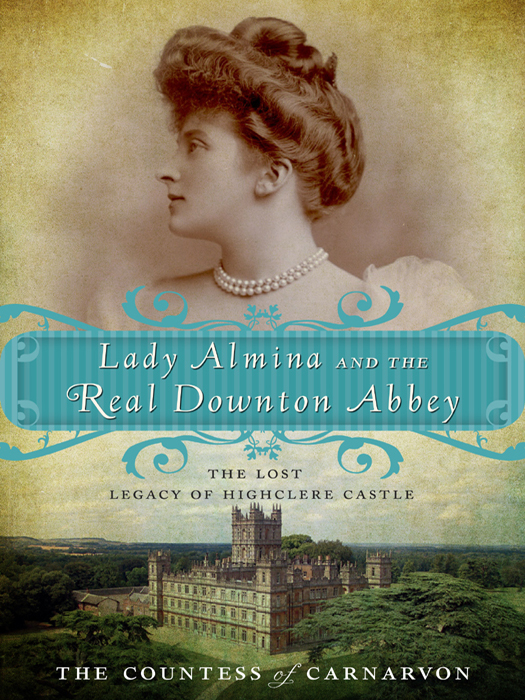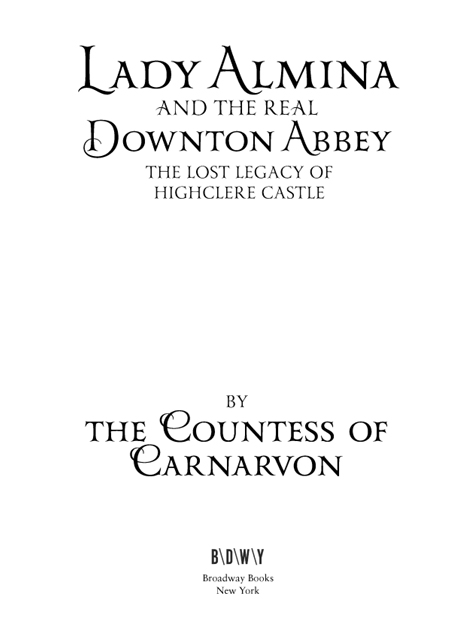Lady Almina and the Real Downton Abbey copyright 2011 by 8th Countess of Carnarvon
Lady Catherine, the Earl, and the Real Downton Abbey copyright 2013 by 8th Countess of Carnarvon
Readers group guides copyright 2013 by Broadway Books
All rights reserved. Published in the United States by Broadway Books, an imprint of the Crown Publishing Group, a division of Random House LLC, a Penguin Random House Company, New York.
www.crownpublishing.com
Broadway Books and its logo, B \ D \ W \ Y, are trademarks of Random House LLC.
Downton Abbey is a registered trademark of Carnival Films Ltd.
The works in this collection were originally published separately as follows:
Lady Almina and the Real Downton Abbey was originally published in hardcover in Great Britain by Hodder & Stoughton, a Hachette U.K. company, London, in 2011, and was subsequently published in paperback in the United States by Broadway Books, an imprint of the Crown Publishing Group, a division of Random House LLC, a Penguin Random House Company, New York, in 2011.
v3.1_r6
Lady Catherine, the Earl, and the Real Downton Abbey was originally published in hardcover in Great Britain by Hadder & Sloughton, a Hachette U.K. company, London, in 2013, and was subsequently published in paperback in the United States by Broadway Books, an imprint of the Crown Publishing Group, a division of Random House LLC, a Penguin Random House Company, New York, in 2013.
v3.1
Lady Almina and the Real Downton Abbey cover design by Laura Klynstra
Lady Almina and the Real Downton Abbey cover photography: Highclere Castle Archive
Lady Catherine, the Earl, and the Real Downton Abbey cover design by Laura Klynstra
Lady Catherine, the Earl, and the Real Downton Abbey cover photograph and painting: Highclere Castle Enterprises LLP 2013
eBook ISBN 978-0-8041-4087-4
v3.1
Contents
For my husband and son, who I adore,
and my beloved sisters
Contents
Prologue
This is a book about an extraordinary woman called Almina Carnarvon, the family into which she married, the Castle that became her home, the people who worked there, and the transformation of the Castle when it became a hospital for wounded soldiers during the First World War.
It is not a history, although it is set against the exuberance of the Edwardian period, the sombre gravity of the Great War and the early years of recovery after the conflict.
It is neither a biography nor a work of fiction, but places characters in historical settings, as identified from letters, diaries, visitor books and household accounts written at the time.
Almina Carnarvon was an enormously wealthy heiress, the illegitimate daughter of Alfred de Rothschild. She was contracted in marriage to the 5th Earl of Carnarvon, a key player in Edwardian society in Britain. His interests were many and eclectic. He loved books and travel and pursued every opportunity to explore the technologies that were transforming his age. Most famously he discovered the tomb of Tutankhamun with Howard Carter.
Almina was an unbelievably generous woman in spirit and with her money. She was a guest at some of the greatest royal pageants, until as it did for so many people the First World War transformed her life, involving her in running hospitals instead of great house parties and showing her to be an adept nurse and skilled healer.
Highclere Castle is still home to the Earls of Carnarvon. Via its television alter ego, Downton Abbey, it is known to millions of people as the setting for a drama that has thrilled viewers in more than a hundred countries around the world.
Living here for the past twelve years, I have come to know the bones and stones of the Castle. My research has revealed some of the stories of the fascinating people who lived here, but there is so much more. My journey has just started.
The Countess of Carnarvon

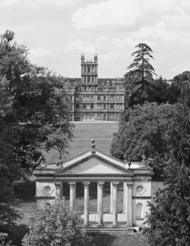
1
Pomp and Circumstance
On Wednesday 26 June 1895, Miss Almina Victoria Marie Alexandra Wombwell, a startlingly pretty nineteen-year-old of somewhat dubious social standing, married George Edward Stanhope Molyneux Herbert, the 5th Earl of Carnarvon, at St Margarets, Westminster.
It was a lovely day, and the thousand-year-old white stone church was crowded with people and overflowing with gorgeous flowers. Some of the congregation on the grooms side might perhaps have remarked that the decorations were a little ostentatious. The nave had been filled with tall potted palm trees whilst ferns spilled from the recesses. The chancel and sanctuary were adorned with white lilies, orchids, peonies and roses. There was a distinct touch of the exotic, combined with the heady scents of English summer flowers. It was an unusual spectacle, but then everything about this wedding was unusual. Alminas name, the circumstances of her birth and most of all her exceptional wealth, all contributed to the fact that this was no typical Society wedding.
The Earl was getting married on his twenty-ninth birthday. His family and title were distinguished and he was slim and charming, if somewhat reserved. He owned houses in London, Hampshire, Somerset, Nottinghamshire and Derbyshire. His estates were grand; the houses were filled with paintings by the Old Masters, objects brought back from trips to the East and beautiful French furniture. Naturally he was received in every drawing room in the country and invited to every party in London, especially where there was an eligible daughter or niece for him to meet. Though they would doubtless have been gracious on such a special occasion, there must have been some inwardly disappointed ladies in the congregation that day.
He arrived with his best man, Prince Victor Duleep Singh, a friend from Eton and then Cambridge. The Prince was the son of the ex-Maharaja of Punjab, who had owned the Koh-i-Noor diamond before it was confiscated by the British for inclusion in the Crown Jewels of Queen Victoria, Empress of India.
The sun poured through the new stained-glass windows, which depicted English heroes across the centuries. The ancient church, which stands next to Westminster Abbey, had recently been refurbished by Sir George Gilbert Scott, the pre-eminent Victorian architect. The church was, in fact, a quintessentially Victorian blend of the traditional and the modern. It was the perfect setting for this marriage of people who came from such different sections of society, but who were each in possession of something the other needed.
As the organist, Mr Baines, struck up the opening chords of the hymn The Voice That Breathed oer Eden, Almina, who had been waiting in the entrance porch, took her first steps. She walked slowly and with as much calm and dignity as she could muster with all those eyes upon her, her gloved hand resting lightly on that of her uncle, Sir George Wombwell. There must have been nerves, but she was excited, too. Her soon-to-be-husbands brother-in-law, Lord Burghclere, had remarked that she was something of a nave damsel, but also that she appeared to be head over ears in love and could barely contain herself in the weeks and days leading up to her wedding day.


